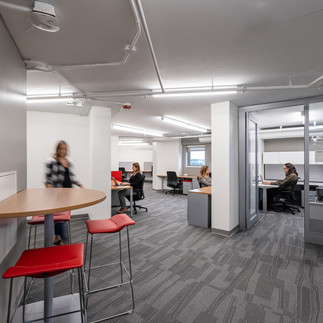How is Technology Impacting the Modern Office?
- Katelyn Riffel & Chuck Andrews
- May 5, 2023
- 3 min read

Technology plays a big role in our day to day lives and the spaces we work in. Sometimes it’s obvious from phones in our hands, to the VR goggles on our heads. other times it’s so subtle we don’t notice it. Working in the design and construction industry, we’ve seen how we can use technology to change the way buildings are built, as well as change how we use the spaces within. We can see how technology helps to address environmental concerns with the development of cleaner building materials and more efficient building systems. Technology has also been used to help our physical and mental health by providing opportunities for more flexible workspaces, access to daylight, clean air and secure spaces. As our work changes, we are excited to see how technology evolves to support the work we do. Below we’ve listed a few of the big ways we’ve seen technology impact the modern office:
HVAC controls and Building Automation Systems
Integrated systems simplify commands and provide better control over comfort and efficiency. Studies have shown that residential and commercial buildings account for one-third of global carbon dioxide emissions.
Used to boost heating and cooling efficiency more than 20 percent. These systems provide versatility for measuring energy sub-metering, tenant energy metering, demand response, cost allocation and troubleshooting problems or issues.
Such systems allow separate and distinct control over zones/rooms. Sensors can detect when spaces are occupied and manage temperature, humidity and CO2 accordingly, leading to improvement of indoor air quality.
Lighting
LED lighting options offer a longer life while wasting little energy. They provide more lumens per watt than incandescent or fluorescent lighting and have higher lumen output than conventional fixtures. They are also higher in brightness, provide a wide range of colors, instantaneous operation, are not affected by cold temperatures, and are recyclable.
Daylight harvesting uses daylight to offset electric lighting to properly light a space in order to reduce energy use. This system uses photosensors to detect light levels (luminance), adjusting electric lighting based on available daylight within the space. Energy savings in the range of 20-60% is common.
Smart blinds/curtains and motorized shades that raise/lower on a set schedule are an effective way to save on energy costs. These can be powered by solar-charged battery packs. Users are able to set schedules, enable sunrise/sunset functions, and can adjust from mobile devices. Smart blinds allow for a more comfortable work environment while also saving building energy costs.
Occupancy/vacancy sensors detect motion and turns lights on and off automatically.
Space
Hybrid office is defined as an arrangement in which a company’s managers and employees sometimes work together in a physical office and sometimes work remotely.[1] Working this way requires investing in collaboration tools, IT infrastructure, and scheduling.
Office Hoteling is a reservation based style of office management. Employees schedule their time to be on-site and use mobile apps to find and reserve space. This allows users to sit where they want, depending on what work is to be performed and/or who they need to collaborate with.
Benefits – improve employee experience, ensures access to office resources, encourages collaboration/teamwork, improves space utilization, reducing overhead costs.
Teleconferencing introduces the ability to meet virtually with team members through live video and audio. Teleconferencing allows collaboration in the hybrid workplace connecting teams from different locations as well as broadening the reach of a business by allowing communications beyond the physical office. Some tools to achieve efficiency:
Video conferencing within modular phone booths
Acoustics
Interactive display boards
Occupancy sensors within spaces provide a way to track the use of desking and conference space to allow managers to better determine best space use, offering opportunities for real estate efficiency and building management.
Touchless restroom accessories such as towel dispensers, automatic flush, water, and soap dispensers, and automatic door openers can also help with various types of efficiency.
Furniture
Adjustable height tables/desks can be raised/lowered on demand and/or Bluetooth enabled.
Battery powered workstations are movable for team collaboration, and allow for more flexible space use.
Security
Cameras
Card access
Proximity cards – no need to pull cards out
Temperature readers
Automatic door openers
All of these tools can work in collaboration with each other, creating a high-tech workspace. This can help not only with building efficiencies as well as enhanced employee productivity.
[1] Investopedia, Business, Business Essentials, “Hybrid Office” by Amy Fontinelle, updated January 31, 2023















